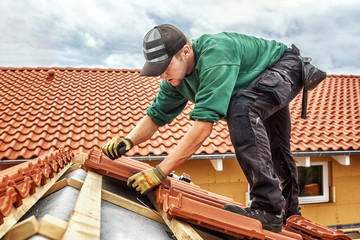What Does a Roofer Do?
Roofers, known as roof mechanics or roofing contractors, specialize in roof construction. They repair, replace, and install the roofs of buildings using a wide variety of materials.
They typically work with a team of construction professionals. Roofers tend to be realistic individuals who are independent, stable, persistent, thrifty, and enjoy tactile, physical, and athletic tasks.
Roofers install, repair, and replace the roofs of buildings. They use various roofing materials, including shingles, bitumen, and metal. Properly installed roofs safeguard building interiors and exteriors from water damage, protect structural integrity, and increase energy efficiency. Roofers must be comfortable working at heights and using ladders. They must also follow all safety guidelines when performing tasks on roofs.
During the installation process, roofers measure and cut roofing materials to size and shape. They may install vapor barriers and insulation to create more energy-efficient and waterproof structures. They also ensure that the roof is properly aligned, secured, and weatherproofed. After the installation is complete, roofers clean up debris and inspect the roof for any leaks or damage.
Commercial roofers work on larger building projects, such as shopping centers and office buildings. These jobs require them to travel between job sites and climb ladders or scaffolding to access the roof. They often interact with clients and other contractors to discuss project details and answer questions.
Residential roofers work on single-family homes and multi-unit housing complexes. These jobs require them to navigate through residential neighborhoods and use ladders or scaffolding to reach the roofs. They may also interact with homeowners to discuss project details and address concerns.
Small business roofers are typically run by a single person or a small team of people. They have low overhead costs and are able to offer competitive prices. However, they are not always able to provide the same level of customer service as large companies.
Metal roofers specialize in installing and repairing roofs made from metals such as aluminum or copper. They must have extensive knowledge of specialized roofing materials and techniques. Slate and tile roofers work with natural or synthetic slate, clay, or concrete tiles. These roofs must be carefully installed to ensure they are durable and visually appealing.
Repair
Roofers use a wide range of hand tools to make repairs. They can repair or replace shingle and flat roofing, install skylight windows, and re-slate and tile roofs. They may also work on cladding and lead sheeting. In general, roofers have to be fairly physically fit to perform their duties because they spend most of the day on ladders, either ripping off old roofing materials or carrying new shingles up to the roof.
For large scale repairs, a roofer will usually assess the damage and then remove all the old roofing material, tarps and debris, including the underlying plywood or OSB. They will then re-install the flashing, membrane and shingles using their choice of fixing methods, which could include nails or sealant (similar to roofing cement). Nails should only be used where they are unlikely to come into contact with water, for example around vents, chimneys and dormer corners. Otherwise, roofers usually prefer to use sealant as it is more water resistant and can be painted to match the surrounding shingles.
In emergency situations, such as major storm damage, roofers will try to tarp the affected area to prevent further rainwater ingress and potential structural damage. They will then prioritize their work according to the level of damage, with urgent repairs such as a collapsed or leaking roof getting top priority. They will often offer to assist with insurance claims, helping homeowners to navigate the tricky paperwork.
Maintenance
Roofers perform maintenance on existing roofs as well as installing new ones. This includes repairing damaged areas, sealing leaks, replacing shingles, and ensuring that the roof is watertight. They may also be responsible for laying vapor barriers and insulation. They can also repair gutters and downspouts, as well as install roof flashing. Generally, roofers work as crew members for roofing contractors. This means that they are responsible for tearing off the old shingles, inspecting and repairing the sheathing, removing debris from the site, and following the instructions of the project foreman.
The job of a roofer is very physical and requires a high degree of stamina. It involves climbing, bending, kneeling, and working in extreme weather conditions. Additionally, it is dangerous because of the potential for falls from heights. As a result, many roofers are required to wear protective equipment and follow strict safety requirements.
When it comes to maintenance, a good roofer will regularly clean the surface of the roof to prevent the buildup of dirt and grime. They can also remove organic material from the roof, such as leaves and branches. They will clean the gutters, downspouts, and eavestroughs to ensure that they are functioning properly.
In addition, a roofer will often use roofing cement and nails to replace or repair shingle pieces that have become loose or cracked. They may also use roofing cement to patch up the valleys of the roof, which are the corners between the individual slopes of the roof. In some cases, a roofer will need to replace the metal flashing around chimneys, vents, and wall flashings if they are corroded or rotting.
Roofers also need to be familiar with a wide range of construction materials and techniques. They should be able to choose the appropriate roof materials for each project and apply them correctly to ensure that the roof is durable and watertight. In some instances, they may even be required to spray paint the sheathing and other surfaces of a building to add protection or enhance its aesthetic appeal.
Sales
Roofers often work as part of a larger sales team. They may also do some actual roofing work on occasion as well. These individuals tend to have thrifty personalities and prefer physical, mechanical and intellectual activities. They are also good at following procedures and processes.
Residential roofing sales is all about selling on value and relationship. The key is to control the frame of conversation by teaching customers how your services can improve their quality of life and solve problems. A good way to do that is to share photos of previous projects in their neighborhood. This is a meaningful conversation starter that can help set you apart from the competition.
Another way to enhance your sales pitch is to offer a variety of payment options, including financing. Many homeowners don’t realize that they can finance a new roof, and this is an effective tool to ease the blow of a costly investment. It’s important to know whether or not your customers will be paying out of pocket or filing a claim with their insurance company.
Lastly, it’s helpful to have a detailed sales presentation that you can present when meeting with prospective customers. This will allow you to present the various roofing materials that you have available and give you the opportunity to negotiate. If you use a pro contractor software app like iRoofing, you can show off past projects and share testimonials in a seamless manner with potential customers. This will increase your credibility and make the process more efficient for everyone involved. Most importantly, it will ensure that you’re not missing any opportunities to sell. Those who aren’t skilled at sales often end up quitting the profession too soon, as they can’t handle the long periods of rejection and lack of income.

